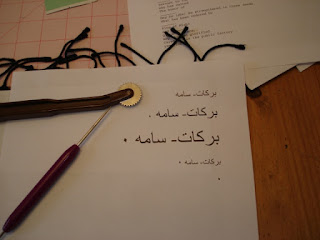Sayyeda Samia al-Kaslaania
Copyright March 2011, Julia May
 |
A TAPESTRY TIRAZ FRAGMENT, 9TH-10TH CENTURY, FATIMID. Christie's Sale 5331, item 535. Indian and Islamic Works of Art and Textiles 11 April 2008, London, South Kensington
During the Middle Ages, rulers in the Middle East would honor selected people by giving them gifts inscribed with tiraz. In the Fatimid period these were called khil’a, or robes of honor. These “robes” ranged from a scarf or handkerchief (mandil), to a tunic, to an entire outfit (hulla). Typically they were adorned with a formulaic inscription: honoring god and the royalty, asking for blessings, and often including a date and location of manufacture.
 |
| Tiraz shawl completed by Samia. |
 |
| Comparing the tracing wheel to the seam ripper. |
In the spirit of the SCA award system, I asked Duke Garrick to translate text for an award which I based off of extant Fatimid examples. Because I don’t translate Arabic, I kept the text simple so that it could be used for many different awards. If I know the recipient would not be offended, I have included the Bismallah with other pieces. With this shawl, I do not know the recipient and left off the prayer.
Blessings to _____, servant to the Kingdom of Northshield who has earned the honor of_______.
May he [she] be strengthened in these deeds. What has been ordered by ______, King of Might
and ______, Queen of Grace, may they be glorified. Cared for in the public factory year __[A.S.].
 | |
| Scale of the text to the shawl. |
The tricky part of this project was getting the Arabic words transferred to the dark fabric. Pouncing with chalk was not going to work for this stuff-it-the-bag-and-take-it-with-me project. My solution was to use modern waxy transfer paper and the end of a seam ripper to punch the design on to the fabric (as you can see in this image, the tracing wheel would be too large for this project). I carried the printout with me so I could add diacritical marks as needed. Typically, embroidered pieces in this period don’t include the short vowel markings, so only the “dots” were transferred.
Period examples show that text was sometimes written in ink on fabric, and some pieces were glazed (like modern polished apple fabric) and then stamped before working the embroidery. Many extant pieces allow the reverse of the embroidery to be exposed, knots and all, however I have elected to cover the back with plain fabric.
 | |
| The tracing paper between the printed text and the fabric. |
 |
| The embroidered "signature". |

Neat! Lovely work.
ReplyDeleteWhat is the size though? It doesn't look very big, but then tiraz bands aren't really.
Thank you for the question. Each row is less than 1/2 inch tall.
ReplyDeleteI've noticed the disparity between extant tiraz and illuminated tiraz before as well. The image of me on the right hand side of the page has tiraz that are similar in size to what is seen in the illuminated Maqamat al-Hariri. But, as you say, extant tiraz are rarely that tall.